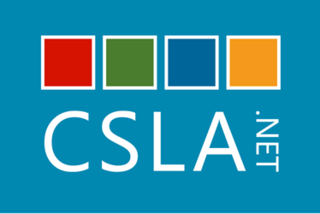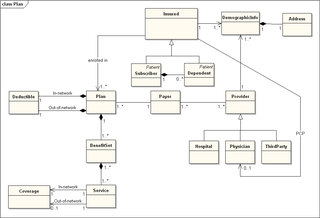Related Research Articles
In software engineering, multitier architecture is a client–server architecture in which presentation, application processing and data management functions are physically separated. The most widespread use of multitier architecture is the three-tier architecture.

A data model is an abstract model that organizes elements of data and standardizes how they relate to one another and to the properties of real-world entities. For instance, a data model may specify that the data element representing a car be composed of a number of other elements which, in turn, represent the color and size of the car and define its owner.
In computer science, an object can be a variable, a data structure, a function, or a method. As regions of memory, objects contain a value and are referenced by identifiers.
A surrogate key in a database is a unique identifier for either an entity in the modeled world or an object in the database. The surrogate key is not derived from application data, unlike a natural key.

An entity–relationship model describes interrelated things of interest in a specific domain of knowledge. A basic ER model is composed of entity types and specifies relationships that can exist between entities.

Data modeling in software engineering is the process of creating a data model for an information system by applying certain formal techniques. It may be applied as part of broader Model-driven engineering (MDE) concept.

CSLA .NET is a software framework created by Rockford Lhotka that provides a standard way to create robust object oriented programs using business objects. Business objects are objects that abstract business entities in an object oriented program. Some examples of business entities include sales orders, employees, or invoices.
Object–relational impedance mismatch is a set of difficulties going between data in relational data stores and data in domain-driven object models. Relational Database Management Systems (RDBMS) is the standard method for storing data in a dedicated database, while object-orientated (OO) programming is the default method for business-centric design in programming languages. The problem lies in neither relational databases nor OO programming, but in the conceptual difficulty mapping between the two logic models. Both logical models are differently implementable using database servers, programming languages, design patterns, or other technologies. Issues range from application to enterprise scale, whenever stored relational data is used in domain-driven object models, and vice versa. Object-oriented data stores can trade this problem for other implementation difficulties.

In software engineering, a domain model is a conceptual model of the domain that incorporates both behavior and data. In ontology engineering, a domain model is a formal representation of a knowledge domain with concepts, roles, datatypes, individuals, and rules, typically grounded in a description logic.
This is an alphabetical list of articles pertaining specifically to software engineering.
In software engineering, the active record pattern is an architectural pattern. It is found in software that stores in-memory object data in relational databases. It was named by Martin Fowler in his 2003 book Patterns of Enterprise Application Architecture. The interface of an object conforming to this pattern would include functions such as Insert, Update, and Delete, plus properties that correspond more or less directly to the columns in the underlying database table.
General Responsibility Assignment Software Patterns, abbreviated GRASP, is a set of "nine fundamental principles in object design and responsibility assignment" first published by Craig Larman in his 1997 book Applying UML and Patterns.
The anemic domain model is described as a programming anti-pattern where the domain objects contain little or no business logic like validations, calculations, rules, and so forth. The business logic is thus baked into the architecture of the program itself, making refactoring and maintenance more difficult and time-consuming.
An entity–attribute–value model (EAV) is a data model optimized for the space-efficient storage of sparse—or ad-hoc—property or data values, intended for situations where runtime usage patterns are arbitrary, subject to user variation, or otherwise unforeseeable using a fixed design. The use-case targets applications which offer a large or rich system of defined property types, which are in turn appropriate to a wide set of entities, but where typically only a small, specific selection of these are instantiated for a given entity. Therefore, this type of data model relates to the mathematical notion of a sparse matrix. EAV is also known as object–attribute–value model, vertical database model, and open schema.
Object-oriented design (OOD) is the process of planning a system of interacting objects for the purpose of solving a software problem. It is a method for software design. By defining classes and their functionality for their children, each object can run the same implementation of the class with its own state.

A database model is a type of data model that determines the logical structure of a database. It fundamentally determines in which manner data can be stored, organized and manipulated. The most popular example of a database model is the relational model, which uses a table-based format.
Domain-driven design (DDD) is a major software design approach, focusing on modeling software to match a domain according to input from that domain's experts.
The front controller software design pattern is listed in several pattern catalogs and is related to the design of web applications. It is "a controller that handles all requests for a website," which is a useful structure for web application developers to achieve flexibility and reuse without code redundancy.
In information systems, applications architecture or application architecture is one of several architecture domains that form the pillars of an enterprise architecture (EA).

Object-oriented programming (OOP) is a programming paradigm based on the concept of objects, which can contain data and code: data in the form of fields, and code in the form of procedures. In OOP, computer programs are designed by making them out of objects that interact with one another.
References
- Rockford Lhotka, Visual Basic 6.0 Business Objects, ISBN 1-86100-107-X
- Rockford Lhotka, Expert C# Business Objects, ISBN 1-59059-344-8
- Rockford Lhotka, Expert One-on-One Visual Basic .NET Business Objects, ISBN 1-59059-145-3